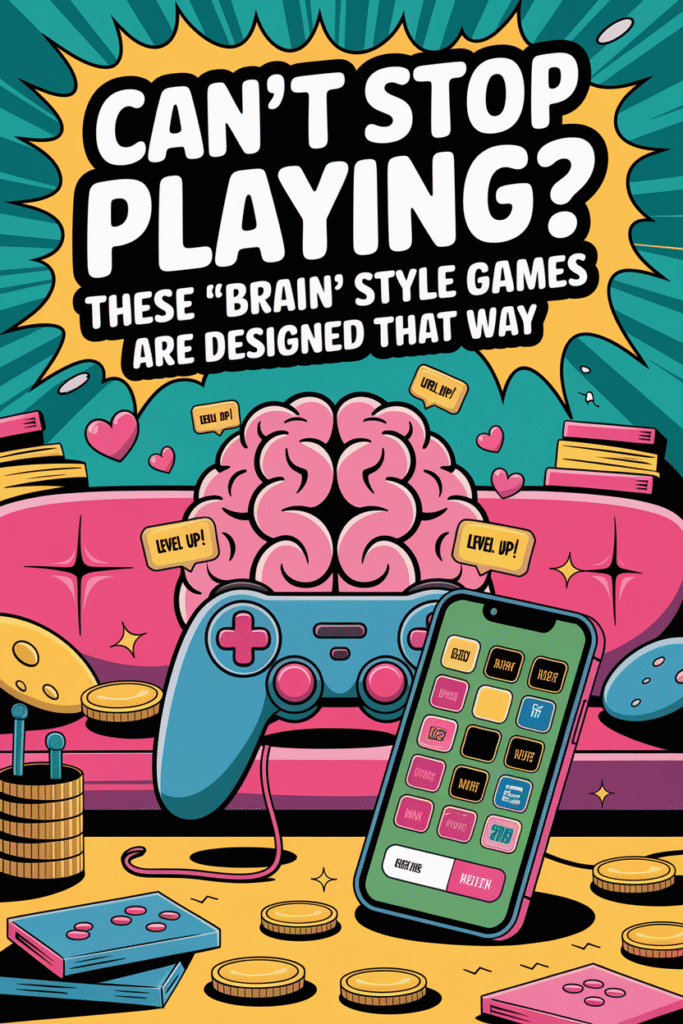I’ve come across a new term today that I was unfamiliar with: Brain Rot Games. If you’ve spent any time on TikTok or Reddit lately, you’ve probably heard the term “brain rot games.” These are the ultra-addictive, often mindless mobile or browser games that suck you in for hours—even though you can’t quite explain why you’re playing them.
But what exactly are brain rot games? Why are they so popular? And are they actually bad for you?
Let’s break it down and have a chat.
What Are Brain Rot Games?
Brain rot games refer to low-effort, high-reward games designed to stimulate your brain’s dopamine centers with as little cognitive load as possible. They often feature:
- Simple mechanics (tap, swipe, or idle)
- Endless progression (no clear end goal)
- Bright visuals and repetitive sounds
- Quick feedback loops
Think of games like:
- Ball Sort Puzzle
- Sand Sort Puzzle
- Color Match
- Stacky Dash
- Candy Crush
- Cookie Clicker
These games are typically free, ad-heavy, and designed for short attention spans. You open them for a minute—and 45 minutes later, you’re still sorting digital sand.
These games are becoming more and more popular in this day and age due to our ever increasingly short attention spans (thanks Tik Tok).
The Psychology Behind Brain Rot Games
1. Dopamine Loops
Brain rot games work by hijacking your dopamine system—the part of your brain that rewards you for completing tasks. Every level-up, combo, or achievement gives a tiny dopamine hit, keeping you in a loop. It’s the exact same process why we find ourselves scrolling tik tok or reels for an hour on end, only to find yourself thinking ‘how did I even get here?”
2. Low Cognitive Demand
Unlike strategy or narrative games, these require little to no thinking. They’re perfect for when you’re bored, tired, or scrolling mindlessly. These games also feel a little different than just your everyday scrolling. Your playing a game, which has to be better than just mindlessly scrolling instagram right?
3. Instant Gratification
They give you constant wins. Whether it’s popping bubbles or stacking colors, you’re always achieving something—even if it’s meaningless.
These days we are always looking for the next form of instant gratification, online shopping? Scrolling reels, mindless games? Check, check and check.
Are Brain Rot Games Really That Bad?
The term “brain rot” sounds extreme, but it’s more of a meme than anything. That said, overindulgence in these types of games can lead to:
- Reduced attention span
- Procrastination
- Mental fatigue
- Sleep disruption (hello, late-night gaming)
Lately I have noticed just how bad my attention span has gotten. It feels like I can’t do more than 5-10 minutes of work without having to reach for something on my phone.
Still, not all brain rot is bad. Sometimes you need a mental break, and tapping colorful blobs is way better than doomscrolling social media.
The key is moderation.
Why Are Brain Rot Games Trending in 2025?
There are a few reasons for the rise of brain rot games:
1. TikTok Culture
Short-form videos and brain rot games go hand in hand. Many games gain popularity through viral gameplay clips with captions like “my brain is mush but I can’t stop”.
2. Increased Screen Time
Post-pandemic habits have made us more reliant on phones for entertainment. Quick games are perfect for micro-breaks.
3. Stress Relief
In a world of constant anxiety, these games offer mindless relief. No stress, no stakes, just pixels.
Examples of Popular Brain Rot Games
Here’s a list of games currently dominating the brain rot category in 2025:
| Game | Platform | Why It’s Addictive |
| Sand Balls | Mobile | Satisfying physics and endless puzzles |
| Water Sort Puzzle | Mobile | Color sorting + infinite levels |
| Antistress: Relaxing Games | Mobile | 30+ mini-games to fidget with |
| Mob Control | Mobile | Simple army mechanics, oddly satisfying |
| Subway Surfers | Mobile | Fast-paced, colorful, nostalgic |
Should You Quit Brain Rot Games?
If your screen time app is sending you warning notifications, it might be time to take a break. But you don’t necessarily have to quit cold turkey.
Here are a few tips to regain control:
- Set time limits using built-in app settings
- Replace with more engaging games (e.g., puzzles or story-based)
- Try offline hobbies to reduce screen dependency
- Use brain rot games only as a reward after completing tasks
Brain rot games are here to stay—and in moderation, they’re harmless fun. They reflect a broader cultural trend: the craving for easy, quick, feel-good entertainment.
So next time you find yourself stacking digital crates for 30 minutes straight, just know you’re not alone. Just maybe… put the phone down before bed.


